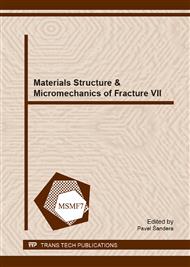[1]
D. Lidbury, 1st Biennial conference on through Life Toughness Prediction in reactor Steels, 6-8/02/06, Heviz, Hungary. "Multi-scale modeling in the RPV Mechanics sub-project will link the flow and fracture behavior or irradiated RPV materials at the micro- and macro level.
Google Scholar
[2]
Ж. Фридель. Дислокации, пер. с англ. под ред. А.Л. Ройтбурда, Изд. Мир. М. (1967).
Google Scholar
[3]
Р. Хоникомб, Пластическая деформация металлов, пер. с англ. под ред. Б.Я. Любова, Изд. Мир. М. (1972).
Google Scholar
[4]
P. Hornak, I. Zrnek, V. Vrochovski, Aspects of thermal fatigue deformation process of wrought Ni-based super Alou pp.179-184. LCFIC, 7-11/09, 98, Garmisch-PartenKirchen, Germany. Ed. K.T. Rie and P.D. Portella 1998, Elsevier Science.
Google Scholar
[5]
Osamu Umesawa and KotobuNagal, Effects of test temperature on internal fatigue crack generation… in austenitic steels, pp.3017-3028. Metall. Transactions A., v. 29A, N12, (1998).
DOI: 10.1007/s11661-998-0209-8
Google Scholar
[6]
Z.F. Zhang and Z.G. Wang, Relationship between the fatigue cracking probability and the grain-boundary category, V. 80, pages 483-488, (2010).
DOI: 10.1080/09500830050057189
Google Scholar
[7]
D.L. McDowell and F.P.E. Dunne, Microstructure-sensitive computational modeling of fatigue cracks formation, International Journal of fatigue, 2010, v: 32, Pages: 1521-1542.
DOI: 10.1016/j.ijfatigue.2010.01.003
Google Scholar
[8]
T. Eterashvili, M. Vardosanidze, Metallographic and SEM research of LCF deformation in austenitic steels, 5 IC on Low Cycle Fatigue, Berlin, Germany September 9-11, 2003 (P 72).
DOI: 10.4028/www.scientific.net/kem.665.141
Google Scholar
[9]
T. Markus Welsch, Shaker Verlag GmbH – Dissertation, Saarland University, 2011, Bildung von MikrorissenanKorngrenzen: Einfluss der Orientierung auf lokale Oberflächenspannungen und auf die Ermüdungsrissbildung.
Google Scholar
[10]
S. Heino and B. Karlsson, Cyclic deformation and fatigue behavior of 7Mo-0, 5N super austenitic stainless steel-slip characteristics and development of dislocation structures, pp.353-363. ActaMaterialia, v. 49 (2), (2001).
DOI: 10.1016/s1359-6454(00)00200-7
Google Scholar
[11]
James Rice R., Dislocation nucleation from a crack tip: an analysis based on the Peierls concept. J. Mech. Phys. Solids, V. 40, N2, 1992, Ñ. 239-271.
DOI: 10.1016/s0022-5096(05)80012-2
Google Scholar
[12]
Agar Uguz and John Martin , Plastic Zone Size Measurement Techniques for Metallic Materials, Materials Characterization N 37, 1996, pp.105-118.
DOI: 10.1016/s1044-5803(96)00074-5
Google Scholar
[13]
S.G. Roberts, Modeling crack tip plastic zones and brittle- ductile transitions, Mat. Sci. and Engineering, A 234-236 (1997), pp.52-58.
DOI: 10.1016/s0921-5093(97)00180-9
Google Scholar


